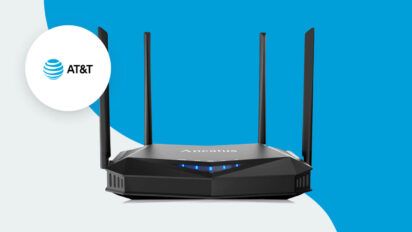AT&T offers customers two installation options ― standard professional installation and self-installation. Standard professional installation is included with AT&T plans at no extra cost. However, if you’re a do-it-yourselfer or want to avoid the hassle of scheduling an installation appointment, you can set up your own service.
If you’re a new AT&T Fiber customer, professional installation will be your only option if your house does not already have fiber internet compatibility (fiber cables installed). If you’ve had fiber in the past, then self-installation just involves hooking up your new equipment. Self-installation is fairly simple if you’re an AT&T DSL or fixed wireless customer.
If instruction manuals make you cringe, we’re here to help! Keep reading to learn how to set up your AT&T Internet from start to finish.
What’s included in your installation kit?
- AT&T Wi-Fi gateway device
- Green Ethernet cable (for AT&T Internet)
- RED ONT Ethernet cable (AT&T Fiber)
- Yellow Ethernet cable
- Power cord
- Gray phone cable
- Instruction manual
AT&T internet self-installation guide
Note: If you have a traditional (non-digital) home phone system, you’ll need to connect your phone to a dual-port filter (included in your equipment package). Plug the dual-port filter into your phone jack, then plug your phone into one of the filter’s ports. The other port will be used to connect with your gateway.
Step 1: Connect your Gateway. Your AT&T equipment package comes with color-coded wiring, which matches up with color-coded ports on your Gateway.
- Plug the green data cable into the green Broadband (DSL) port and your wall jack (if you use traditional phone service, it will plug into your dual-port filter).
- Plug the gray cable into the Gateway’s Phone Lines 1 & 2 ports and your phone (if you use traditional phone service, plug the cable into your phone and the Phone port on the dual-port filter).
- Plug the black power cord into an electrical outlet and your Gateway.
If you intend to use a wired internet connection (rather than a wireless/Wi-Fi connection), plug the yellow Ethernet cable into the Gateway’s yellow Ethernet port and your computer.
Give your Gateway about 10 minutes to power up. The Broadband and, if applicable, Service lights will turn solid green when it’s ready to go. If neither of these lights turns solid green after 10 minutes, view the Troubleshooting section.
Step 2: Set up your Wi-Fi network. On your device or computer, open your Wireless Network Settings. Select your Wi-Fi Network Name (SSID) and enter your 12-character password (both are listed on the sticker on your Gateway). Next, open your browser and follow the online registration instructions. If registration doesn’t start automatically, go to att.com/Uverse. If you already registered online, you should be good to go.
Step 3: Customize your settings with the Smart Home Manager app. Open the Smart Home Manager app on your device or visit att.com/smarthomemanager to customize your Wi-Fi network name and password. You can then start connecting other devices to your network using your personalized settings.
AT&T Fiber℠ self-installation guide
Step 1: Connect the AT&T Fiber℠ Service Box. Your service box (Optical Network Terminal or ONT) is the device that connects your home to the AT&T Internet system. It may be mounted on a wall in the basement, garage or utility closet. Remove the cover and connect the following:
- Plug the green fiber connecter to the green PON port (if not already connected). CAUTION: Do not look into the end of the fiber connector as this can cause eye damage.
- Plug the red ONT Ethernet cable into the service box Ethernet port.
- Plug the black power cord into the service box and an electrical outlet. Make sure the ON/OFF button is pressed in.
If the power cord is missing or anything appears damaged, call AT&T customer service at 800.288.2020.
Next, wait for the Power and PON lights to turn solid green, then follow steps 2 and 3 from the section above. If the Power and PON lights are off or do not turn solid green, view the Troubleshooting section below.
Step 2: Connect your Gateway. Your AT&T equipment package comes with color-coded wiring, which matches up with color-coded ports on your Gateway.
- Connect the red ONT Ethernet cable from your service box to the ONT port on your Gateway.
- Plug the Gateway’s black power cord into the device and an electrical outlet.
If you intend to use a wired internet connection (rather than a wireless/Wi-Fi connection), plug the yellow Ethernet cable into the Gateway’s yellow Ethernet port and your computer. If you have digital phone service, plug the gray cable from the Gateway’s Phone Lines 1 & 2 port to your phone.
Give your Gateway about 10 minutes to power up. The Broadband and, if applicable, Service lights will turn solid green when it’s ready to go. If neither of these lights turns solid green after 10 minutes, view the Troubleshooting section.
Step 3: Set up your Wi-Fi network. On your device or computer, open your Wireless Network Settings. Select your Wi-Fi Network Name (SSID) and enter your 12-character password (both are listed on the sticker on your Gateway). Next, open your browser and follow the online registration instructions. If registration doesn’t start automatically, go to att.com/Uverse. If you already registered online, you should be good to go.
Step 4: Customize your settings with the Smart Home Manager app. Open the Smart Home Manager app on your device or visit att.com/smarthomemanager to customize your Wi-Fi network name and password. You can then start connecting other devices to your network using your personalized settings.
Troubleshooting
If your Gateway Broadband light doesn’t turn solid green during power-up:
- Check your service activation date. You can only install service after 2 p.m. on your service activation date, which is noted on your packing slip.
- Check your connections and power. Make sure all the cables and cords are connected securely. If the Power light on your Gateway isn’t green, try another outlet.
- Unplug and replug. Unplug the Gateway power cord for 15 seconds, then plug it back in. Give the device up to two minutes to reboot.
If your Gateway Service light (if applicable) doesn’t turn solid green during power-up:
- Unplug and replug. Unplug the Gateway power cord for 15 seconds, then plug it back in. Allow at least two minutes to reboot. If the light is still red, contact AT&T technical support.
If your Gateway Power light is amber:
- Give it a moment. The light turns amber during the device’s power-up process. Do not unplug any cables during this time.
If you have any other questions or concerns, contact AT&T technical support (800.288.2020) or visit the AT&T Support Center.
Should you self-install AT&T internet?
AT&T self-installation is quicker and less expensive than professional installation. If your residence already has AT&T services set up and you’re comfortable with setting up internet equipment, AT&T self-installation could be a great option.
Pros
-
Cheaper – AT&T self-installation is cheaper than professional installation.
-
Faster – Self-installing your AT&T internet service could save you time.
-
No appointment necessary – You don’t need to worry about scheduling appointments when you install your own AT&T internet.
Cons
-
Limited assistances for troubleshooting – If you encounter issues while installing, you’ll need to contact customer service which could increase the duration of the process.
-
May not work – Sometimes self-installing your internet service doesn’t always work and you might have to troubleshoot.
-
Network issues – Professional installation ensures your network is working perfectly. With self-installation, issues may go unnoticed.
How to schedule professional installation
If AT&T self-installation doesn’t work, you can still schedule a professional installation appointment. Professional installation is best if your residence has not had AT&T service for over a year or your home’s cables or outlets look damaged. It also ensures that your network will work smoothly since the technician will be there to check everything over.
You can schedule professional installation when you order your AT&T internet service or call AT&T customer service.
AT&T self-installation FAQs
My equipment package is missing a piece. What should I do?
Contact AT&T technical support to have a replacement sent to you.
How do I change my Wi-Fi network name?
You can change your network’s name and password through the Smart Home Manager app, or at att.com/smarthomemanager.
How do I install an AT&T Smart Wi-Fi Extender?
- First, plug your power cord into the Wi-Fi Extender, then plug it into an electrical outlet near your Gateway. Push the power button and wait about three minutes for the Wi-Fi Extender’s light to blink green.
- Next, press the WPS button on your Gateway and the WPS button on your Wi-Fi Extender. The flashing light will turn solid green when the devices are paired, which usually takes about three minutes.
- Finally, unplug your Wi-Fi Extender from the outlet, move it to its new location, and plug it into a nearby electrical outlet. The light will turn green when the connection with the Gateway is reestablished, which usually takes a few minutes. For best results, keep your Wi-Fi Extender within 40 ft. of your Gateway, and no more than two walls or one floor away. Be sure to keep it in an open spot where other objects can’t block its signal.
Find the best AT&T routers for your home internet connection.
For more guides, news and other internet information, visit our Resource Center.

Written by:
Camryn Smith
Cammy is a writer with Allconnect, growing her broadband industry knowledge for over a year on the internet marketplace. Her expertise lies in home internet and broadband service with a focus on providers, plans…
Read more
Edited by:
Robin LaytonEditor, Broadband Content
Related pages
-
Featured
![How to self-install your AT&T internet]() How to self-install your AT&T internet Camryn Smith — 7 min read
How to self-install your AT&T internet Camryn Smith — 7 min read -
Featured
![The best AT&T routers]() The best AT&T routers Camryn Smith — 5 min read
The best AT&T routers Camryn Smith — 5 min read -
Featured
![ACP program allows eligible households to get high-speed internet for free]() ACP program allows eligible households to get high-speed internet for free Robin Layton — 2 min read
ACP program allows eligible households to get high-speed internet for free Robin Layton — 2 min read
Latest
-
Thursday, April 18, 2024
Comcast introduces new pre-paid internet, mobile and streaming plansRobin Layton — 2 min read
-
Thursday, April 18, 2024
T-Mobile imposes data cap of 1.2TB/mo.Robin Layton — 2 min read
-
Thursday, April 18, 2024
What is a portable Wi-Fi hotspot?Robin Layton — 6 min read






